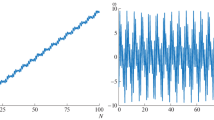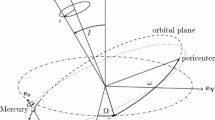Abstract
The fluctuation in the angular velocity of the present rotation of Mercury is investigated. The instantaneous rotational rate in terms of orbital mean motion at different positions along Mercury's orbit is given. At aphelion the rotational velocity decreases substantially because the solar gravitational torque on the two thermal bulges on Mercury's surface tends to retard the rotation of Mercury before aphelion passage. It is found that the difference between the rotational periods derived from the motions at perihelion and aphelion is 4.68 min and that the maximum rate of rotation occurs atf=π/4 andf=7π/4, wheref is the true anomaly.
Similar content being viewed by others
References
Liu, H. S.: 1969, ‘On the Figure of Mercury,’Celestial Mechanics 2, 31.
Liu, H. S. and O'Keefe, J. A.: 1965, ‘Theory of Rotation for the Planet Mercury,’Science 150, 1717.
Author information
Authors and Affiliations
Rights and permissions
About this article
Cite this article
Liu, HS. A note on the instantaneous rotational velocity of Mercury. Celestial Mechanics 2, 123–126 (1970). https://doi.org/10.1007/BF01230457
Received:
Issue Date:
DOI: https://doi.org/10.1007/BF01230457




